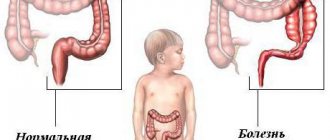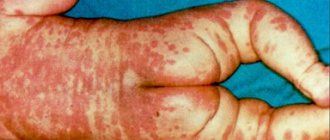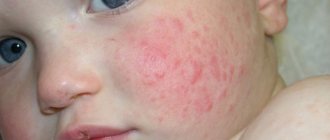About the disease
Gastritis is one of the most common diseases of the gastrointestinal tract (GIT), which occurs more often in children, starting from school age.
The disease is characterized by the formation of a focus of inflammation in the gastric mucosa. This is how characteristic clinical symptoms appear, which can be provoked by both external and internal causes. The pathology can be acute or chronic. The danger of the disease lies in the disruption of digestive function and the possible development of serious complications that worsen the patient’s quality of life. If left untreated, gastritis progresses from childhood into adulthood.
Symptoms of gastritis
The pathogenetic basis of gastritis is inflammation of the gastric mucosa. Because of this, local edema develops with impaired function. The secretion of enzymes decreases and digestion worsens. In parallel, a number of characteristic clinical signs arise:
- pain in the abdomen (“in the pit of the stomach”). They intensify when the child is hungry, because... there is additional secretion of gastric juice, which irritates the mucous membrane;
- loss of appetite;
- irritability;
- the formation of a white coating on the tongue;
- belching sour or rotten with bad breath;
- nausea, vomiting - these symptoms are characteristic of a severe course of the disease.
Due to disruption of the normal digestion process and loss of appetite, the child begins to eat less. There is a lack of vitamins and minerals, which is accompanied by secondary symptoms - pale skin, deterioration in the quality of hair and nails. With prolonged absence of adequate nutrition, the child begins to lose weight, anemia develops, blood pressure decreases, and the heart rate (HR) increases. In the case of a bacterial infection (phlegmonous gastritis), high fever appears (up to 39-40°C) with a marked deterioration in the condition of the small patient. Such patients require immediate hospitalization.
Symptoms of gastritis in children
General symptoms of all types of gastritis:
- Painful sensations. Most often, with gastritis, children complain of pain in the upper abdomen (in the area where the stomach is located). The intensity of the pain syndrome depends on the severity of the inflammatory process and the perception of pain by a particular child. Therefore, pain in the epigastric region can be either mild, non-intense, or painfully strong;
- Discomfort and heaviness in the stomach area. It happens either as an isolated symptom or combined with pain, occurring when it subsides or in the interictal period;
- Heartburn. Children note its intensification when bending the body and physical activity. This symptom manifests itself as a burning sensation in the upper stomach and behind the sternum. Some children may notice a burning sensation spreading throughout the esophagus to the level of the pharynx. At the same time, there is a feeling of sourness in the mouth;
- Belching of air or small amounts of food eaten. In this case, the child may develop bad breath;
- Poor appetite and the child’s refusal to eat;
- Nausea and vomiting. Both of these symptoms can either accompany each other or occur in isolation;
- Disruption of digestive processes. Inflammation in the stomach disrupts one of the first stages of food processing, which leads to failure in all parts of the digestive process. Children experience bloating, loose stools or constipation, anemia, hypovitaminosis and other symptoms of malabsorption of nutrients;
- Palpation pain in the epigastric region. Sometimes in children with thinned subcutaneous fatty tissue, a spasmodic stomach in the form of a cord is detected;
- External changes. The presence of gastritis with impaired digestion can be indirectly judged by pale skin and a grayish or whitish coating on the tongue.
Features of manifestations of chronic atrophic gastritis:
- Rarely occurs in children;
- What comes to the fore is not pain, but dyspeptic syndrome in the form of heaviness in the stomach, impaired digestion and absorption of nutrients;
- Atrophic gastritis causes a disturbance in the general condition of the child, anemia and hypovitaminosis.
Symptoms of chronic hyperacid gastritis, in which excess gastric secretion occurs, are as follows:
- Pain is the main manifestation. It is triggered by the child’s food intake or physical activity;
- Heartburn and sour belching;
- The general condition of the child is rarely disturbed. Local pain and gastric disorders predominate.
Acute gastritis is characterized by the following symptoms:
- Vomiting predominates. Sometimes she becomes indomitable;
- Constant pain in the stomach;
- Violation of the child’s general condition, lethargy with prolonged persistence of vomiting.
Causes of gastritis
The most common cause of gastritis is dietary errors.
Eating too spicy, fatty, hot, rough food leads to mechanical and chemical irritation of the child’s gastric mucosa, which is accompanied by the appearance of typical signs of the disease. It is worth noting that if such a diet violation is episodic in nature, the disease may not have time to develop. In addition to the nutritional (food) aspect, pathogenic microorganisms play an important role in the etiology of gastritis. Most often, the cause of the disease is bacteria that enter the child’s stomach with poor-quality food (food poisoning). A similar effect occurs when using aggressive medications, alcohol or drugs.
An important endogenous cause of gastritis in children is the bacterium Helicobacter Pylori. The pathogen normally lives in the pyloric part of the stomach, and if there are appropriate conditions for its reproduction, it affects the entire surface of the mucous membrane of the organ. The bacterium secretes aggressive toxins that irritate the inner layer of the stomach and provoke inadequate secretion of hydrochloric acid. The result of this phenomenon is the development of gastritis.
Additional provoking factors are considered:
- hereditary predisposition;
- irregular food intake;
- eating large amounts of fast food, snacks (chips, crackers), carbonated drinks;
- chronic diseases of other gastrointestinal organs in the acute stage (cholecystitis, pancreatitis);
- seasonal weakening of immune defense;
- uncontrolled use of medications (antipyretics, antibiotics, hormonal agents).
Acute gastritis in children
Any child who is fed food products other than breast milk can develop acute gastritis. This type of disease is an inflammation of the gastric mucosa caused by harmful environmental factors. First of all, these are food products consumed by the child. For older children, gastritis can be caused by any food that is of poor quality or infected with pathogenic microbes. In addition to these products, young children accidentally ingest toxic substances (potassium permanganate, rat poison, medications, household chemicals). When they come into direct contact with the surface of the stomach, either a burn of the mucous membrane of varying degrees occurs, or its irritation with the development of an acute inflammatory process.
Acute gastritis can initially have different degrees of severity and manifestations, which depends on the severity of damage to the mucous membrane:
- Superficial inflammatory process in the upper layers;
- Deep inflammation spreading throughout the entire thickness of the mucosa;
- The formation of superficial small eroded changes against the background of inflammation;
- Gastritis with profound destructive and inflammatory changes in the gastric mucosa.
The specific type of pathological changes determines the severity of the clinical manifestations of acute gastritis in a child:
- Vomiting. It can be one-time in case of a superficial inflammatory process, or be indomitable in case of deep destructive changes;
- Pain syndrome. Almost always, with acute gastritis, gastric spasm occurs, which is manifested by severe pain in the projection of the stomach (upper abdomen);
- General weakness and impairment of general condition. More typical for severe acute gastritis with repeated vomiting and dehydration. The appearance of these symptoms is an alarming signal and requires parents and specialists to pay special attention to such children.
If acute gastritis is represented by superficial inflammatory changes, then it does not pose any threat to the child’s health. After a short-term deterioration, with proper treatment, the child’s condition improves and the disease goes away without a trace. The situation is completely different with acute gastritis against the background of gross morphological changes in the gastric mucosa. Such children require specialized help, since there is an immediate threat not only to the health, but also to the life of the child. After all, their result can be gastric bleeding, intoxication or dehydration.
On topic: prevention of gastritis
Diagnosis of gastritis
“SM-Doctor” is a medical center whose gastroenterologists have many years of successful experience in the early detection and treatment of gastritis of any etiology in children aged 0 to 18 years. Our own laboratory and modern diagnostic equipment guarantees the identification of the root cause of inflammation in the stomach in the shortest possible time. The gastroenterologist begins the diagnosis of gastritis by collecting a history of the disease and analyzing the patient’s complaints. After this, the specialist palpates the abdomen and conducts a full physical examination. To confirm the final diagnosis, the doctor prescribes the following auxiliary tests and procedures:
- fibroesophagogastroduodenoscopy (FEGD) is an endoscopic technique that allows you to visually assess the condition of the gastric mucosa and identify the area of damage;
- pH-metry is a technique for assessing the acidity of the stomach contents;
- general clinical tests (blood, urine).
To identify the presence of H. Pylori, the doctor may prescribe a urease breath test or a specialized serological blood test (determines the concentration of antibodies to the corresponding pathogen). Positive results of these tests influence the choice of treatment for the patient.
Chronic gastritis in children
Chronic gastritis differs from an acute inflammatory process in the gastric mucosa not only in the duration of its course, but also in the mechanism of its occurrence. This means that the chronic process is characterized by a long course, relatively mild symptoms, a tendency to periodic exacerbations and subsidence of inflammation and symptoms. If acute gastritis is always a sudden onset and rapid progression, then chronic gastritis, on the contrary, is a gradual onset and prolonged inflammation. These features are based on the cause of each of these types of gastritis.
Chronic gastritis in children occurs as a result of disruption of the secretory and motor activity of the stomach against the background of a decrease in the protective properties of its mucous membrane. In this case, a situation arises when an excess amount of gastric juice is synthesized with its prolonged stagnation. An unprotected mucous membrane is unable to withstand such aggressive environments. The consequence of this imbalance between protective and irritating mechanisms is a kind of self-digestion of the mucous membrane with gastric contents, accompanied by an inflammatory process.
The described pathogenetic basis of chronic gastritis underlies its clinical manifestations and course of the disease. This suggests that the disease becomes a kind of companion in the child’s life and reminds itself of itself with another exacerbation with every error in the diet.
This wave-like course is characterized by the following symptoms:
- Pain in the stomach area;
- Heaviness and belching;
- Heartburn with nausea;
- A rare disorder of the general condition of the child.
All these features form the basis of the treatment program for chronic hypersecretory gastritis. It is radically different from that of its acute variety. But we must not forget about other variants of chronic gastritis, which are not accompanied by hypersecretion, but, on the contrary, by its decrease. They are based on atrophic changes in the mucosa, in which gastric cells irreversibly self-destruct, losing their function. Such forms of the disease are rare in childhood.
Treatment of gastritis
Gastritis is a gastrointestinal disease, the key aspect of treatment of which remains diet.
The child should eat often, but in fractional portions. Fried, fatty foods, smoked foods, spicy seasonings, and marinades are temporarily excluded. All food must be boiled or steamed. It is recommended to feed the child pureed foods to minimize mechanical irritation of the gastric mucosa. Medication correction of the baby’s well-being is achieved using the following groups of drugs:
- proton pump inhibitors (Pantoprazole, Omeprazole), which reduce acidity;
- enveloping drugs - Almagel, Gaviscon;
- antibiotics (Metronidazole, Clarithromycin) are used to identify H. Pylori or other pathogenic bacteria.
In case of serious complications (bleeding, perforation, etc.), surgical intervention may be required.
Prevention of gastritis of any etiology involves eating well-heat-treated food in fractional portions. It is recommended not to abuse fast food. But the main thing is regular, nutritious meals. Gastritis is often also called “students’ disease” due to constant dry snacks. “SM-Doctor” is an advanced medical center that provides a full package of diagnostic and therapeutic services to patients with various forms of gastritis. The sooner the child begins to receive adequate treatment, the faster he will recover.
Treatment of gastritis in children
The complex of therapeutic measures for gastritis in children depends on the type of the disease. Differentiated tactics are presented in table form.
| Treatment of acute gastritis |
|
| Treatment of chronic gastritis |
|










